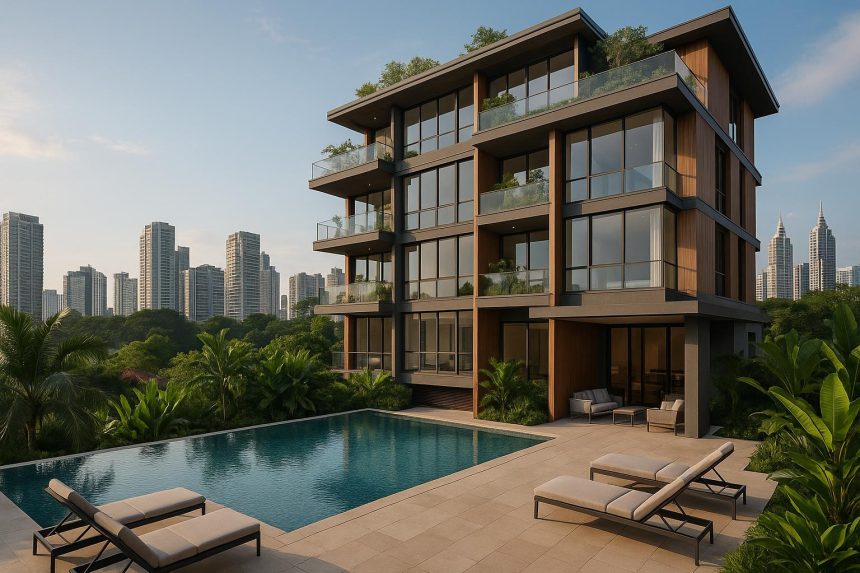The Singapore property landscape has witnessed a fascinating shift lately. While mega-developments with thousands of units continue to dominate headlines, savvy homebuyers are increasingly drawn to something different—boutique residential projects that prioritize exclusivity and personalized living experiences. One development capturing this trend is Pinery Residences, a thoughtfully designed condominium that exemplifies what modern luxury means in today's market.
The Appeal of Intimate Living Spaces
There's something inherently different about walking into a development where your neighbors aren't strangers lost in a sea of 800 units. Boutique condominiums typically house fewer than 200 units, creating an environment where community actually means something. Residents recognize each other at the lobby, management staff know you by name, and the facilities never feel overcrowded on weekends.
This intimacy extends beyond social comfort. Smaller developments often translate to better maintenance standards, faster response times to resident concerns, and a genuine sense of ownership that larger projects struggle to replicate. The management team isn't juggling thousands of households—they're focusing on a manageable community where quality of service can truly shine.
Location Intelligence Over Size
Boutique developments succeed partly because they occupy land parcels that mega-developers often overlook. These smaller sites frequently sit in mature, well-connected neighborhoods where residents enjoy established amenities, proven rental demand, and proximity to business districts. The trade-off between massive facilities and strategic location increasingly favors the latter, especially for professionals who value time saved on daily commutes.
Singapore's urban planning has evolved to create distinct neighborhood identities. Living in a boutique development within these established zones means tapping into existing community infrastructure—hawker centers with decades of history, neighborhood schools with strong reputations, parks where generations have played, and transport nodes refined over years of use.
Architectural Thoughtfulness
Walk through most large-scale developments, and you'll notice a pattern: repetitive unit layouts replicated across multiple towers to maximize efficiency. Boutique projects take a different approach. With fewer units to design, architects can dedicate more attention to optimizing layouts, enhancing natural ventilation, and ensuring each unit captures the best views available on the site.
This architectural mindfulness shows up in unexpected ways. Corner units genuinely feel special rather than merely commanding a price premium. Living rooms are proportioned for actual furniture arrangements, not just to meet minimum square footage requirements. Balconies are designed as extensions of living spaces, not afterthoughts carved from what's left after meeting density requirements.
Facility Quality Over Quantity
The facilities arms race in Singapore property development has reached absurd proportions. Do you really need three swimming pools, two gyms, and a rock-climbing wall? Boutique developments often answer this by focusing on fewer, higher-quality facilities. Instead of a massive gym that's poorly maintained because the management fund is stretched thin, you get a well-equipped, properly air-conditioned space that's cleaned daily and never overcrowded.
The economic reality is straightforward: maintenance funds divided by fewer units means more resources per resident for upkeep. This mathematical advantage becomes visible within years of completion, when boutique developments maintain their sparkle while larger projects begin showing signs of strain in their expansive common areas.
The Investment Perspective
From an investment standpoint, boutique condominiums occupy an interesting market position. They attract owner-occupiers seeking quality living environments, which stabilizes the resident profile and reduces transience. This appeals to tenants willing to pay premiums for well-managed, community-oriented buildings where their families will feel at home.
Resale markets also reveal advantages. Smaller developments can't flood the market with competing units when multiple owners decide to sell simultaneously. This supply constraint, combined with the appeal to quality-conscious buyers, often supports price resilience better than you'd see in massive projects where resale units compete against each other and new launches from the same developer.
The Sustainability Factor
Sustainability extends beyond solar panels and rainwater harvesting systems. Boutique developments consume fewer shared resources because there are simply fewer residents using them. The environmental footprint of a 150-unit development differs substantially from a 1,000-unit mega-project, even when factoring in per-capita calculations. Landscaping is more manageable, water consumption for common areas stays reasonable, and energy systems aren't pushed to their limits.
This manageable scale also allows for better implementation of green initiatives. When every resident's participation actually makes a visible difference, community buy-in for sustainable practices increases. Recycling programs, car-sharing schemes, and community gardens succeed in environments where people feel connected to outcomes.
Making the Choice
Choosing between a boutique development and a mega-project isn't about one being objectively better. It's about aligning your purchase with your lifestyle priorities. Do you value the anonymity and extensive facilities of a large development, or does the idea of a close-knit community with thoughtfully designed spaces appeal more?
For many professionals and families in Singapore, the answer increasingly leans toward boutique options. They're tired of feeling like just another unit number in a massive database. They want homes where they're known, where their children can safely roam common areas without getting lost, and where the management actually has time to address concerns properly.
The property market reflects this shift. Boutique launches generate strong interest despite premium pricing because buyers recognize the value proposition. They're not just purchasing square footage—they're investing in a quality of life that larger developments struggle to provide, regardless of their extensive facility lists and impressive marketing materials.
Looking Forward
Singapore's property market maturity has reached a stage where bigger doesn't automatically mean better. Sophisticated buyers are evaluating developments based on holistic living experiences rather than just facility counts and unit sizes. This evolution benefits boutique projects that have always prioritized quality over scale.
As land becomes increasingly scarce and expensive in desirable locations, expect more developers to embrace the boutique concept. The economics work, the market appreciates the product, and the living experience genuinely differs from what mass-market projects deliver. For homebuyers willing to look beyond the marketing hype of mega-developments, boutique condominiums represent a compelling alternative that's worth serious consideration.
Whether you're a first-time buyer or adding to your property portfolio, understanding this market segment opens up options that mainstream property searches often miss. The next time you're evaluating developments, take a closer look at those smaller projects in established neighborhoods. You might discover that the best home for your family isn't the one with the most impressive brochure—it's the one where you can actually imagine living comfortably for years to come.
Lynn Martelli is an editor at Readability. She received her MFA in Creative Writing from Antioch University and has worked as an editor for over 10 years. Lynn has edited a wide variety of books, including fiction, non-fiction, memoirs, and more. In her free time, Lynn enjoys reading, writing, and spending time with her family and friends.















